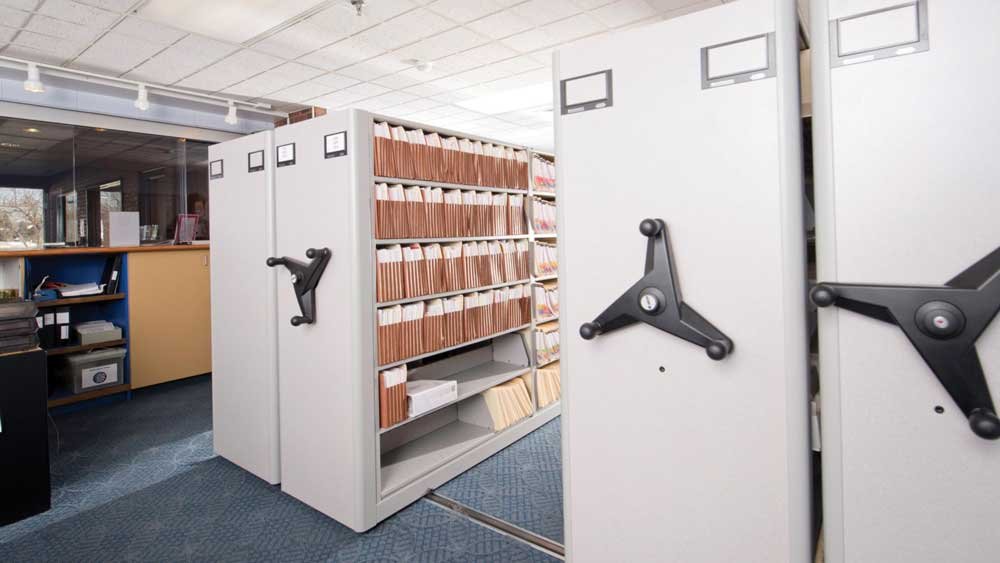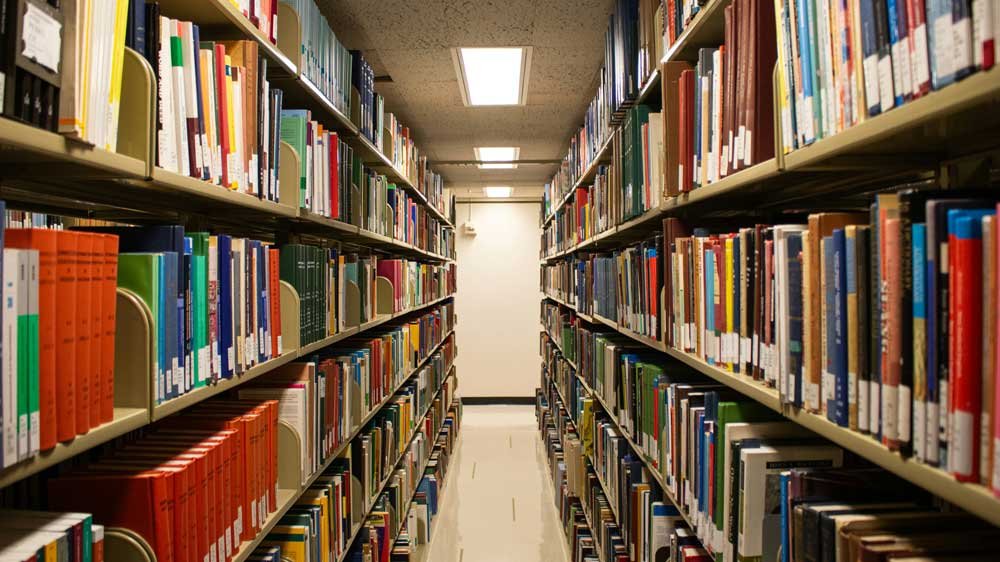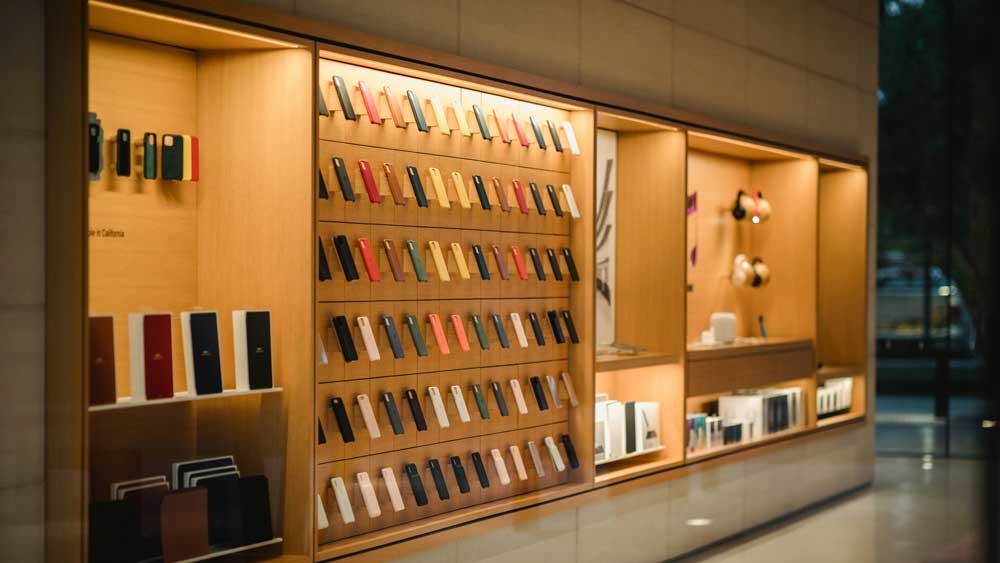In many businesses, managing physical items like paper documents, physical archives, printed materials, or small samples can lead to a host of problems. These often include insufficient space, difficulty locating items, or chaotic organization.
However, the strategic use of bookshelves and bookcases within a business offers a highly effective solution. Drawing from our extensive experience in manufacturing and sales over the years, we’re here to provide you with expert guidance on making informed choices and implementing them effectively.

Professional Distinctions: Bookshelf vs. Bookcase in Business Use
Bookshelf: Definition and Characteristics
In a business context, a bookshelf typically refers to one or more open-shelving units. These are usually made from wood, metal, or other sturdy materials, and their primary purpose is to organize and display various documents, files, equipment, or samples that need to be frequently accessed, retrieved, or shared in daily business operations.
From a practical business operations standpoint, bookshelves have the following core characteristics:
- Openness and Visibility: This is a bookshelf’s most prominent feature. Since it has no doors, all stored items are visible at a glance. This is crucial for materials that require quick location and retrieval, such as archives, reference books, or product samples.
- Easy Access and Return: The open design allows employees to easily store and retrieve items without extra steps (like opening a door). This is especially key in high-efficiency shared areas or next to workstations.
- Categorization and Organization: Even open bookshelves are often effectively partitioned and labeled by businesses. For instance, each shelf might correspond to a project, department, or type of file, ensuring materials are well-ordered and easy to find.
- Space Utilization: Bookshelves make efficient use of vertical space. By adding more shelves, they can store more items within a limited footprint. This is valuable for offices, warehouses, or sample rooms where space is at a premium.
- Flexibility and Configurability: Many business bookshelves are modular, with adjustable shelf heights, and can even be expanded or reduced as needed. This allows them to accommodate items of different sizes and types.
- Collaboration and Sharing Hub: In team work environments, bookshelves often serve as a shared resource center. For example, all team members can find the latest project documents, shared tools, or samples here.
- Cost-Effectiveness: Compared to enclosed filing cabinets or custom storage systems, standardized bookshelves are generally more affordable, making them suitable for businesses with budget constraints or a need for large amounts of general storage.
- Physical Security Considerations: It’s important to note that due to their open nature, bookshelves are generally not suitable for highly confidential or valuable items, as they lack physical locking capabilities.

Bookcase: Definition and Characteristics
In a business context, a bookcase refers to a standalone, enclosed or semi-enclosed furniture unit, typically containing multiple shelves, and featuring doors (such as glass or solid wood doors) or drawers. Its main purpose is to securely, neatly, and protectively (from dust) store or selectively display various physical documents, files, valuable items, or decorative pieces belonging to the company.
From a practical business operations standpoint, bookcases have the following core characteristics:
- Protection and Dust Prevention: This is one of a bookcase’s most crucial features. The structure with doors effectively protects internal items from dust, moisture, or direct light damage, making it particularly suitable for important archives, valuable books, samples, or materials requiring long-term preservation.
- Security and Privacy: Many bookcases come with locking mechanisms, which are essential for storing confidential files, sensitive data, high-value equipment, or personal items. Even without a lock, the physical barrier of the doors provides a degree of visual privacy, preventing unnecessary casual viewing.
- Neatness and Aesthetics: The presence of doors conceals the items inside, making the office environment appear tidier and more organized. Especially with solid wood doors, bookcases can add a professional and steady ambiance to an office space, enhancing its overall image.
- Limited Display Function (for glass doors): If a bookcase has glass doors, it can offer some display functionality while protecting the items inside. This is typically used to showcase company awards, certificates, exquisite product models, company publications, or reference books for visitors to browse, providing both display and protection from casual handling.
- Long-Term Storage and Archiving: Due to their protective nature, bookcases are often used in archives, legal departments, finance departments, and other areas that need to store large volumes of historical and archived documents long-term.
- Space Division and Area Segregation: Tall bookcases can sometimes serve as non-structural dividers, sectioning off different functional areas in an open-plan office while also providing storage.
- Less Frequent Access: Compared to bookshelves, items stored in bookcases usually do not require frequent access. They are more commonly used for materials that need protection, confidentiality, or long-term preservation.

Enterprise Application Scenarios: When to Choose a Bookshelf, When to Choose a Bookcase?
When to Choose a Bookshelf?
Choose a bookshelf when your business needs an open, convenient, high-frequency access storage solution.
Everyday Work Areas and Team Collaboration Zones:
- Scenario: Office cubicles, open-plan offices, shared project team spaces.
- Reason: For storing project files, common reference materials, recent reports, shared stationery, or tools. These items require frequent retrieval and return by team members, and open shelves maximize convenience.
- Example: In a marketing department’s common area, a bookshelf holds various market research reports, competitor analyses, and marketing campaign material samples.
Reference Areas/Small Libraries:
- Scenario: Company internal reading rooms, training rooms, employee break areas.
- Reason: For storing internal company publications, industry magazines, and non-confidential professional books for employees to borrow. Openness helps employees browse and select.
- Example: A bookshelf next to the company’s coffee corner, filled with corporate culture books and employee-recommended reads.
Sample Display Areas:
- Scenario: Product development departments, sales showrooms, design studios.
- Reason: For storing or displaying product samples, models, design drafts, etc. They need to be visually accessible, easy to retrieve, and convenient for client presentations.
- Example: In a clothing company’s design department, the bookshelf displays the latest fabric samples and design sketches.
Temporary File Storage/Categorization Transit:
- Scenario: Administrative departments, reception areas.
- Reason: Used for temporarily placing files awaiting processing, distributing materials, parcels, or as a transit point before files go into archives.
- Example: A bookshelf near the reception desk, used for incoming parcels awaiting signature or internal mail for employees to pick up.
Limited Budget or Flexible Space Needs:
- Reason: Bookshelves are typically more cost-effective than bookcases and offer greater flexibility in spatial arrangement, being easier to move and reconfigure.
When to Choose a Bookcase?
Choose a bookcase when your business requires a storage solution emphasizing protection, privacy, neatness, long-term storage, or display needs.
Executive Offices/Meeting Rooms:
- Scenario: CEO’s office, General Manager’s office, important meeting rooms.
- Reason: For storing crucial contracts, confidential documents, company strategic reports, and other sensitive materials. Glass-door bookcases can be used to display company honors and high-end books, enhancing a professional image.
- Example: In the general manager’s office, a lockable solid wood bookcase holds the company’s annual audit reports and key decision documents.
Finance/Legal/Human Resources Departments:
- Scenario: These departments typically handle large amounts of sensitive and confidential information.
- Reason: For storing employee files, payroll records, financial statements, original contracts, and legal documents. It’s essential to ensure information security and privacy, preventing unauthorized access.
- Example: In the HR department’s archive room, neatly arranged lockable bookcases contain employee onboarding and offboarding records.
Archive Rooms/Document Repositories:
- Scenario: Areas dedicated to centralized storage of large volumes of historical and archived documents.
- Reason: For long-term preservation of paper archives that need protection from dust, moisture, and light. The enclosed nature of bookcases provides a better preservation environment.
- Example: The company’s central archive room, where rows of tightly closed bookcases hold decades of contracts and financial vouchers.
Display of Important Items or Valuables:
- Scenario: Company reception areas, showrooms, honor rooms.
- Reason: Glass-door bookcases can be used to display company trophies, certificates of honor, memorabilia, limited-edition products, or significant collectibles related to corporate culture. This allows for display while effectively protecting the items.
- Example: Next to the honor wall in the company lobby, a beautiful glass bookcase displays industry awards the company has received.
Creating a Formal/Professional Atmosphere:
- Reason: Bookcases (especially solid wood or well-designed models) can bring a sense of gravitas, professionalism, and taste to an office environment, making them suitable for areas where you need to make a strong impression on clients.
Key Factors for Enterprise Procurement of Bookshelves/Bookcases
When a business decides to invest in bookshelves or bookcases, it’s not just about picking out furniture. It’s a strategic decision that impacts efficiency, security, and aesthetics. Here are the crucial factors to consider:
Functionality and Purpose (Core Considerations):
- What will be stored? Think about files, books, samples, equipment, or decorative items. The size, weight, and quantity of items will heavily influence your choice.
- How often will it be used? Is it for daily, high-frequency access or long-term archival storage? This directly determines whether you need an open bookshelf or a closed bookcase.
- Does it involve confidential or valuable items? If so, a lockable or sturdier bookcase is a must-have.
- Is display necessary? If you need to showcase company culture, achievements, or products, a bookcase with glass doors is more suitable.
Space and Dimensions:
- Available space: Accurately measure the length, width, and height of the placement area to ensure the furniture can be smoothly moved in and positioned.
- Space layout: Will it be placed against a wall, or will it serve as a room divider? Will it obstruct pathways or natural light?
- Future expandability: Consider the company’s future growth and increasing storage needs. Do you require a modular, expandable system?
Material and Durability:
- Load-bearing capacity: Especially for shelves/cabinets holding many books, archives, or heavy items, ensure the shelves and overall structure have sufficient load-bearing capacity to prevent deformation or collapse.
- Material selection:
- Metal: Good load-bearing, durable, suitable for functional areas like archives or warehouses.
- Solid wood/Engineered wood: Aesthetic, textured, suitable for offices, meeting rooms. Consider the material’s environmental rating (e.g., E0/E1 standards).
- Glass: Primarily used for cabinet doors to enhance display.
- Surface treatment: Is it moisture-proof, scratch-resistant, and easy to clean?
Safety:
- Structural stability: Ensure the furniture’s structure is stable and not prone to tipping, especially for tall bookcases. It’s best if they have anti-tipping designs or can be secured to the wall.
- Fire resistance: For areas storing important paper documents, consider the fire rating of the materials.
- Locks: If confidentiality is required, the quality and security of the locks are very important.
- Environmental friendliness: Do the materials comply with national or industry environmental standards? Are formaldehyde and other harmful substance emissions within safe limits to ensure employee health?
Design and Aesthetics:
- Style matching: The furniture’s style should harmonize with the overall office decor and corporate culture.
- Color and texture: Choose colors that complement the interior palette to create a harmonious visual effect.
- Detailing: Features like smooth edges, hardware quality, and adjustable shelf holes reflect overall quality.
- Brand image: For areas visible to external parties, the furniture’s appearance is also part of the company’s brand image.
Budget and Cost-Effectiveness:
- Procurement budget: Choose the product that offers the best value for money within your budget.
- Long-term investment: Consider the furniture’s durability. Opting for good quality products can reduce future repair and replacement costs.
- Installation and transportation costs: Understand if these are included in the quote.
Supplier and After-Sales Service:
- Supplier reputation: Choose suppliers with a good reputation and extensive experience in serving businesses.
- After-sales guarantee: Understand the warranty period, repair services, and return/exchange policies to ensure timely resolution if issues arise.
- Customization capability: If you have special size or functional requirements, can the supplier offer customization services?
Ergonomics and Ease of Use:
- Shelf height: Is it adjustable to accommodate items of different heights?
- Access height: Ensure the most frequently used items are placed at a height that is easily accessible to employees.
Conclusion
Choosing the right bookshelf or bookcase is a crucial step for any business looking to enhance its management and efficiency. We hope this article has provided you with valuable insights to make the correct selection for your needs.
If you have further requirements for shelving, display racks, or custom bookcases, please don’t hesitate to contact us for a free solution and quote!

